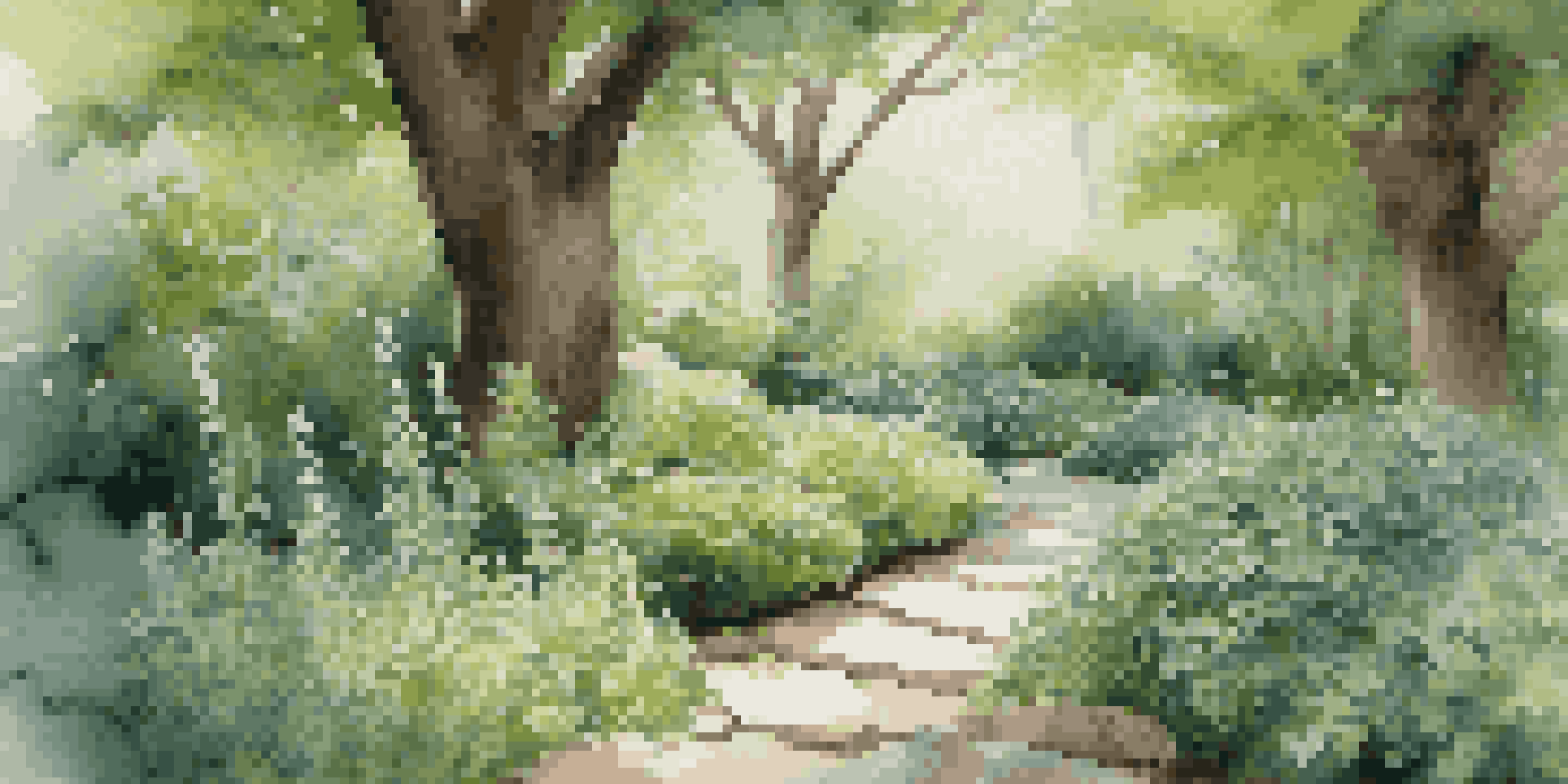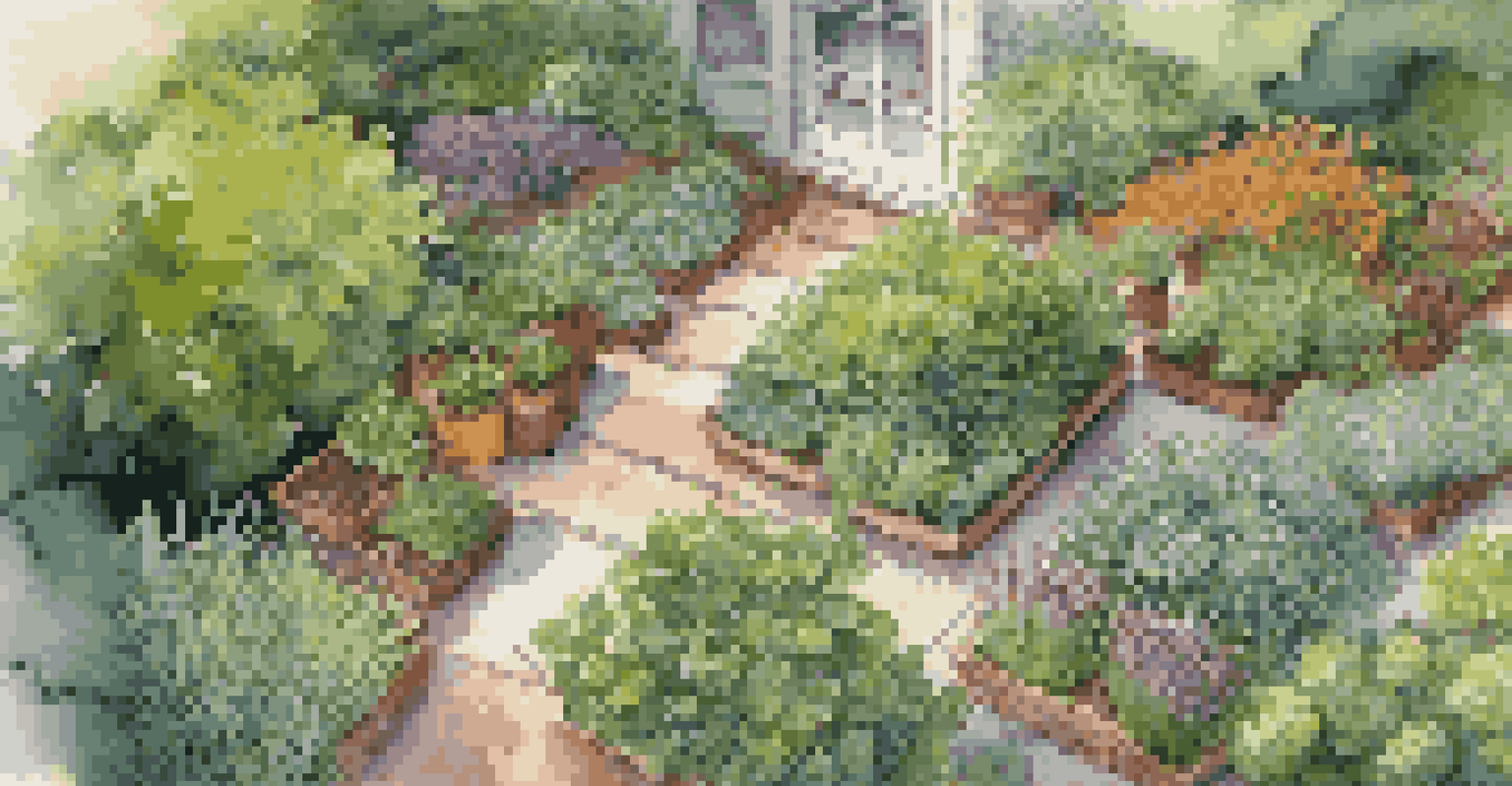Herbs to Grow in Shade: Low-Light Gardening Tips

Understanding Shade in Your Garden
Shade can be a tricky aspect of gardening, but it doesn't have to be a dealbreaker. Knowing what type of shade your garden has—whether it's full, partial, or dappled—can help you choose the right herbs to thrive in those conditions. Full shade means no direct sunlight, while partial shade might receive a few hours of sun each day.
Gardening is a way of showing that you believe in tomorrow.
Shady areas can often be cooler and more humid, which can benefit certain herbs. For instance, areas beneath larger trees might provide a perfect microclimate for some varieties. It's essential to observe your garden's light patterns before planting, as this will guide your choices.
Embracing shade gardening can open up a whole new world of planting possibilities. Instead of viewing shade as a limitation, think of it as an opportunity to cultivate unique herbs that thrive in low-light conditions.
Top Herbs for Low-Light Conditions
There are several herbs that genuinely enjoy the shade, and they can add flavor to your cooking or even serve as beautiful ornamental plants. Some of the top contenders include mint, chives, and parsley, all of which can flourish without direct sunlight. They will not only thrive but can also enhance your culinary creations.

Mint, for example, is known for its vigorous growth, which makes it an excellent choice for shady spots. This herb can spread quite quickly, so keep an eye on it to prevent it from overtaking your garden. Additionally, chives bring a mild onion flavor that can elevate many dishes, making them a fantastic low-light addition.
Understanding Shade Types
Identifying whether your garden has full, partial, or dappled shade will help you select the right herbs that can thrive in those specific conditions.
Another herb to consider is parsley, which is both versatile and easy to grow. It can handle partial shade and still produce lush leaves that are perfect for garnishing or cooking. By choosing the right herbs, you can create a thriving garden even in the shadiest spots.
Soil Preparation for Shade Gardens
Preparing the soil is a crucial step in ensuring your shade garden flourishes. Shady areas often have different soil conditions compared to sunnier spots, so it's important to amend the soil to provide the necessary nutrients. Start with a soil test to understand its pH and nutrient levels, then amend accordingly.
To plant a garden is to believe in tomorrow.
Adding organic matter like compost can significantly improve soil structure, drainage, and nutrient content. This is particularly important in shaded areas where the soil may not be as rich due to reduced sunlight and moisture retention. A well-amended soil will help your herbs establish strong roots and thrive in their environment.
Don’t overlook the importance of mulch, either! A layer of organic mulch can help retain moisture and suppress weeds, creating an ideal environment for your herbs to grow steadily, even in the shade.
Watering Techniques for Shady Herbs
Watering is another critical aspect of low-light gardening. Shady areas typically retain moisture better than sunnier spots, so your watering routine may need some adjustments. It's important to check the soil moisture before watering to avoid over-saturating your herbs, which can lead to root rot.
Using a moisture meter can be a great way to gauge the water needs of your plants. This tool will help you determine when the soil is dry enough for watering while preventing the common mistake of underwatering or overwatering. Remember, herbs in the shade often need less frequent watering than those in direct sunlight.
Top Herbs for Shade Gardening
Herbs like mint, chives, and parsley flourish in low-light conditions, enhancing both your culinary creations and your garden's beauty.
Additionally, consider watering early in the morning or late in the afternoon to minimize evaporation. This ensures that your herbs receive the moisture they need without wasting water in the process. A thoughtful watering strategy will help keep your shade-loving herbs healthy and productive.
Companion Planting in Shade Gardens
Companion planting can be an effective strategy in your shade garden. Some plants can benefit each other by repelling pests, attracting beneficial insects, or improving growth. For instance, planting garlic alongside your herbs can help deter pests while providing a flavorful addition to your garden.
Another great pairing is chives and carrots. Chives can repel certain pests that might harm carrot plants while they both thrive in similar growing conditions. This symbiotic relationship can lead to a healthier garden overall and a more diverse harvest.
When considering companion plants, always think about the specific needs of each plant. Ensuring they share similar light, water, and nutrient requirements will set your shade garden up for success. By carefully selecting companion plants, you can create a lush, productive gardening space.
Maintaining Your Shade Garden
Once your shade garden is established, maintaining it becomes crucial for long-term success. Regularly check your herbs for pests or diseases, as shady conditions can sometimes create a perfect breeding ground for certain issues. Early detection can save your plants from significant damage.
Pruning is another important maintenance task. Regularly trimming your herbs will encourage new growth and prevent them from becoming leggy. This not only keeps your plants healthy but can also provide you with fresh herbs for cooking throughout the growing season.
Importance of Soil and Watering
Preparing nutrient-rich soil and adjusting watering techniques are essential for maintaining healthy, productive herbs in shady environments.
Additionally, consider rotating your herbs each season to keep the soil healthy and reduce the risk of pest infestations. By staying proactive with maintenance, your shade garden can thrive year after year, giving you a bountiful harvest.
Harvesting Your Shade-Grown Herbs
Harvesting is one of the most rewarding parts of gardening. Knowing when and how to harvest your shade-grown herbs can make a significant difference in flavor and plant health. Generally, it's best to harvest in the morning when the essential oils in the herbs are at their peak, resulting in a more flavorful product.
For most herbs, you should cut the stems just above a leaf node, which encourages bushier growth and prolongs the plant's life. Be mindful not to remove more than one-third of the plant at a time, as this can stress it and reduce future growth.

Enjoy the fruits of your labor by incorporating your freshly harvested herbs into your meals or preserving them for later use. Whether it’s a sprinkle of chives on your morning eggs or a mint garnish on desserts, your shade garden can provide you with delightful flavors all season long.